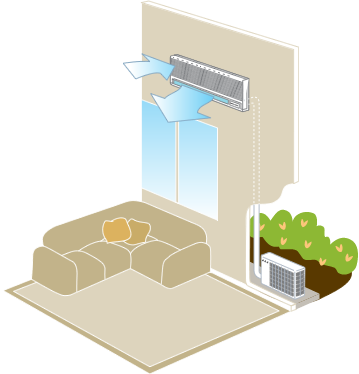Ductless Mini-split Systems
Ductless systems can be useful in “spot cooling” certain areas of a business where special equipment, such as computers or telecommunications equipment, require colder temperatures than the surrounding rooms.
This attribute helps conserve energy. For example, many school systems use ductless systems to conserve energy during the a few rooms used by staff members use ductless systems for similar purposes, saving cooling of the sanctuary for worship days.
Installation and Maintenance
Ductless systems are easy and quick to install. They can be operational within hours. All a contractor needs to do is set up the outdoor condenser coil and compressor, drill a small hole for the copper tubing, hang the indoor fan coil units, connect the tubing and electrical power lines, install the wall controller, and the job is done. Manufacturers ensure that units are charged and tested at the factory so connections can be made quickly, and condensers are designed to be easily serviced.

System Controls
Wall-mounted thermostat or infrared remote control systems allow the user to select the required functions such as temperature and fan speed simply by pushing buttons. The user can even select a delayed start and stop time for unit operation, which makes it possible to have a unit switched on automatically before the homeowner arrives home from work.
Design
The indoor unit of a ductless system is lightweight and comes in a variety of shapes and sizes to fit any design scheme. Outdoor units are designed to be efficient and durable, and they are smaller than conventional units, which makes them easier to disguise behind existing landscaping.
How it Works
To cool your home, refrigerant is pumped from the outdoor condenser coil and compressor through the copper tubing to the indoor unit or units. Inside, the refrigerant is drawn across the evaporator coil and humidity is removed and the air is cooled. A fan in the indoor unit then pushes the cooled air into the room. The amount of cold air entering the room can be controlled by a thermostat or it can be regulated by an infra-red remote controller, similar to a television remote controller.